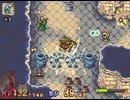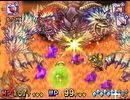|
|

|
PLATFORM
|
DS
|
BATTLE SYSTEM
|

|
INTERACTION
|

|
ORIGINALITY
|

|
STORY
|

|
MUSIC & SOUND
|

|
VISUALS
|

|
CHALLENGE
|
Very Easy
|
COMPLETION TIME
|
Less than 20 Hours
|
|
OVERALL

|
+ Combat is decent
+ Cute, if dated, visuals and enchanting music
- Pretty darned monotonous
- Menu access removed during exploration
- Magic is a pain to use and inessential anyway
|
Click here for scoring definitions
|
|
|
When considering Children of Mana, player expectations must be set at the proper level. This game is trying to be an entertaining dungeon crawler, instead of an epic tale along the line of Secret of Mana and Seiken Densetsu 3. Its success is minimal, but it does not completely fail in its goal either. Dungeon crawler fans can derive some enjoyment, but it is most unlikely anyone else will.
Children of Mana's flow is simple. The player chooses one of four characters upon beginning the game, each of whom plays a little differently. Upon setting out into a dungeon, the player will start smacking enemies that pop up everywhere in real time. Not long into the game four different weapons to lay the smack down with will be present. Each weapon is useful in certain situations and can be easily changed out at any time, with the ability to wield two at once being particularly handy. Enemies cough up a scaled amount of experience upon death, so that the stronger the player's character becomes the less worthwhile killing the same adversaries becomes.
What distinguishes Children of Mana's combat from many other action RPG is its bouncy physics; striking enemies usually causes them to fly back and hit anything in their path, including other enemies or destructible scenery. The player's character is also subject to being bounced around, and will often go careening across the dungeon thanks to ricochets. This mechanic is at least unique, and can be used by the player to make enemies damage each other. It is also irritating when navigation is derailed by an opponent sending the player far away, so bouncy behavior is a mixed blessing.
Fighting enemies takes up the vast majority of time in dungeons, but every floor must be cleared in the same way: a Gleamdrop must be found and carried to a Gleamwell. Every floor has one of each, and the circumstances for uncovering both vary significantly, but doing the same thing over dozens of floors to progress is very monotonous, especially since weapons cannot be used without setting the Gleamdrop down.
 Breaking pots is a common thing, so get used to it.
Breaking pots is a common thing, so get used to it.
|
|
Using items and weapons in combat is easy. One item and two weapons can be assigned to buttons for instant use with no waiting time, and the available options cycled through at any time while paused. Magic is irritating to use, however. Each elemental spirit in the Mana universe has two spells, both used by hitting the B button. One of these spells enhances the protagonist's status or heals, and the other damages enemies. The constructive spell requires the protagonist to stand still for a little while in order to take effect, and the destructive spell does not take effect for several seconds, giving enemies the opportunity to move away from its effects. Physical attacks do the job against every enemy, making magic superfluous.
The effects of weapons and armor can be viewed prior to purchase in the game's sole shop, along with the level at which they can be equipped. The inability to equip powerful items until the character is also powerful can be vexing, but does keep some balance while exploring dungeons. Far more irritating is the lack of access to the equipment menu except at set save points between floors in the dungeons. Needing to wait until a save point (which only occurs after every fourth floor) to try a new piece of equipment does nothing but cause consternation.
If the game was more challenging, the enforced waiting for equipment would be a bigger issue. Losing at any time costs nothing more than time, since it boots the protagonist back to the only town with all experience and items kept. Enemies are dogged in their pursuit but also quite stupid, and simply healing often with the plentiful healing items adorning the landscape is sufficient to remove the risk of defeat. Bosses are powerful but follow patterns that are easily discerned to make defeating them simple.
 An ape, a rhino, and a wolf walked into the science lab one day...
An ape, a rhino, and a wolf walked into the science lab one day...
|
|
Children of Mana's story is entirely disposable, and its brevity is much appreciated for that reason. Essentially, the world's Mana is in danger of overflowing and smothering everything in existence, and some mysterious bad guy named the Mana Lord wants to let that happen because it is the will of Mana. The character selected at the game's beginning has no real effect upon the overall plot, and when the story does appear its highly derivative nature makes the player want it to go away again.
The music in Children of Mana is a definite highlight. Kenji Ito, Masaharu Iwata, and Takayuki Aihara came up with some very engaging tracks to accompany every dungeon. A few of the tracks outside of dungeons aren't memorable, but the vast majority of this game's music is a delight for the ears. Most of its sound effects do the job with the exception of one, a maddening alarm noise that sounds whenever the player's hit points are below one third of maximum. Going into a menu does not stop the sound, and the only way to shut it off is to heal, making it quite a bother.
The visuals are not a problem, but do not display anything that pushes the DS hardware. Everything in this game could have been accomplished on the Game Boy Advance without difficulty. The reuse of sprites from Secret of Mana many years later seems a little lazy, also, since redrawing them would not have been difficult.
Children of Mana can probably be completed in ten hours. There are an enormous number of missions to accept for the extension of that time, but they simply send the player through slightly altered versions of floors in completed dungeons. These missions are the only reason to replay, unless one is able to round up friends for multiplayer.
Children of Mana is probably a different experience if played with friends. It does support Wi-fi, and competing with others for spoils would be a very welcome ability. As a single player dungeon crawler, however, it fails to be memorable. The game is entertaining for short stretches, but better options exist.
Review Archives
|









